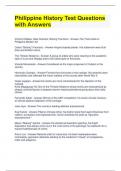Exam (elaborations)
Philippine History Test Questions with Answers
- Course
- Institution
Philippine History Test Questions with Answers Victorio Edades, Galo Ocampo, Botong Francisco - Answer-The Triumvirate of Philippine Modern Art Carlos "Botong" Francisco - Answer-Angono-based painter. His trademark were fluid lines and brilliant colors. The Thirteen Moderns - Answer-A group...
[Show more]



